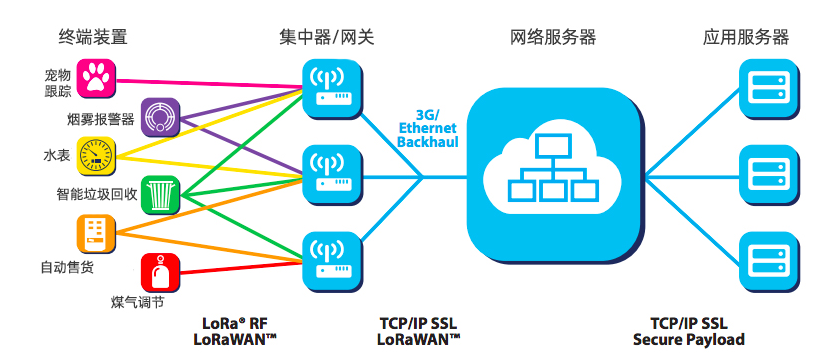The LoRaWAN network architecture is deployed in a star topology (as opposed to a mesh topology, such as Zibgee). The base station of a LoRaWAN network laid out in a star topology relays data between sensor nodes and network servers.
Communication between sensor nodes and base stations occurs over wireless channels using the LoRa physical layer, while connections between gateways and central servers are handled over an IP-based backbone.
● The end node uses LoRa to transmit directly to all gateways within range.
● Gateways use IP to relay messages between end devices and central network servers.

lora terminal node
Terminal nodes can be LoRa embedded modules, LoRa data transmission terminals, sensors, etc. These nodes are usually common:
● Sensors (used to detect changing parameters, such as temperature, humidity, accelerometer, gps);
● LoRa transponder transmits signals through LoRa patented radio transmission method;
● Optional microcontroller (with onboard memory).
The sensor can be connected to a LoRa module, or the sensor can be an integrated unit with a LoRa module embedded in it.
Microcontrollers can be programmed using microPython or microJavascript. This allows developers to use data from sensors such as accelerometers, temperature, etc. and implement certain use cases. The fall detection algorithm can be implemented by programming a microcontroller based on input from accelerometers and other sensors.
LoRaWAN end nodes (sensors) typically use low power and are battery powered (Class A and B). LoRa embedded sensors are battery powered and typically last between 2 and 5 years. LoRa sensors can transmit signals over a distance of 1 km to 10 km.
LoRa gateway
The LoRa sensor transmits data to the LoRa gateway. LoRa gateway connects to the Internet via standard IP protocols and transmits data received from LoRa embedded sensors to the Internet (i.e. network, server or cloud). The gateway-apparaat is always connected to a power source. The gateway connects to the network server via a standard IP connection and acts as a transparent bridge, simply converting RF packets into IP packets and vice versa.
Network Server
The web server can be a cloud-based platform solution. The web server connects to the gateway and drops the packets, then routes them to the relevant application. The web server can be used for uplink (i.e. sensor to application) or downlink (i.e. application to sensor) communication.
The Things Network network server has routers, proxies and handlers for processing packets from the LoRaWAN gateway. It also has an AWS Bridge that connects TTN to the AWS IoT platform.
application server
Applications can typically be built on IoT platforms such as AWS IoT using Lambda, DynamoDb, or S3 services.